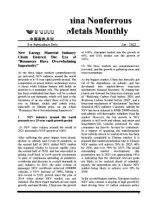Foreign Dependence of Aluminum Resources has Difficulty to be Reduced Significantly
Insufficient resource guarantee ability has long been a bottleneck restricting the development of nonferrous metal industry, and aluminum is no exception. According to data from the China Nonferrous Metal Industry Association, during the “Eleventh Five Year” period China’s bauxite import volume presented a spiral upward trend. In 2010 China’s bauxite import volume was 30.36 million tonnes, up by 53.3% on Y-o-Y basis, in the same year the foreign dependence of bauxite was up to 45.18%.
In fact, the foreign dependence of China’s aluminum resources is even higher. In the production chain of electrolytic aluminum, the raw material being used directly is not bauxite, rather it’s Alumina. While China’s bauxite import is continually increasing, Alumina import also maintained high level, which further highlighted the domestic aluminum resource guarantee ability problem. According to the “Chinese Mineral Resource Report for 2012”, in 2011 the foreign dependence of China’s aluminum resources has reached up to 61.5%.
Over the years, China has made continual efforts to increase aluminum resources’ guarantee ability through measures of intensifying prospecting efforts, and improving ratio of exploitation and reserve. Nevertheless, upon rational analysis, significantly reducing foreign dependence of aluminum resources is in fact a pseudo proposition.
On the one hand, China’s bauxite resources are in relatively short supply compared with its huge consumption. Global bauxite resources are abundant and widely distributed in more than 50 countries on five continents worldwide.Judging from country, Guinea’s and Australia’s bauxite resources account for nearly half of world total. Comparatively speaking, China’s bauxite resources are relatively meager, accounting for only 2.96%. In the aspect of demand, nearly 40% global Alumina production capacity is concentrated in China, which directly results in the fact that China’s bauxite resources can hardly cope with soaring demand.Furthermore, as domestic demand soared, China’s bauxite development and utilization scale continued to expand, domestic bauxite production showed obvious growth. According to statistics, China has overtaken Brazil to become the world’s second largest bauxite producing country in 2009. At present, China is using less than 3% of global reserve to manufacture 17%of global bauxite production, if such trend continues, in the near future China’s bauxite resources will have to face depletion.
On the other hand, China’s bauxite has poor grade, and consequently has no advantage under the same conditions. China’s bauxite is dominated by diasporite bauxite, whose ore grade is poor, which increases the difficulty of processing, Alumina production mostly uses combined method with relatively high energy consumption. Under the same conditions, Chinese enterprises more tend to import overseas high grade ores.
It is worth mentioning that while China’s aluminum resources have poor guarantee ability,its import countries are also over-concentrated.China’s bauxite import is mainly concentrated on Indonesia and Australia, bauxite import volume from these two countries accounts for more than 90% of China’s total bauxite import.Against the background of high level of external dependence and over-concentration of import countries, changes in relevant policies of overseas export countries brought considerable impact to the production and operation of domestic smelting enterprises. In May 2012, Indonesian government announced a policy to ban 14 mineral export including bauxite, resulting in “free fall” decline in China’s bauxite quantity import from Indonesia in the subsequent several months. 5 domestic large Alumina backbone enterprises also one after another announced partial production suspension plan for Alumina production capacity. In order to minimize risk, up till now China has gradually diversified bauxite import countries, and increased import volume from other countries such as Fiji and Jamaica.
In the face of China’s status quo with poor guarantee ability of aluminum resources, China should take full advantage of domestic and overseas resources, speed up technology progress, and blaze a trail of sustainable development. It mainly includes two paths: Firstly,intensify efforts to recycle scrap aluminum resources, increase the percentage of recycled aluminum in aluminum consumption; secondly,strengthen overseas cooperation, actively guide domestic enterprises to actively walk out, and strive to transform overseas aluminum resources indirectly into resources available for use by China.
 China Nonferrous Metals Monthly2013年7期
China Nonferrous Metals Monthly2013年7期
- China Nonferrous Metals Monthly的其它文章
- China’s Major Non-ferrous Metals Imports & Exports
- Fabricated Copper Production by Province or City in 2013
- Production of the Ten Major Nonferrous Metals in 2013
- Magnesium Production by Province in 2013
- Zinc Production by Province in 2013
- Alumina Production by Province in 2013
